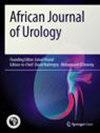Egyptian urinary stones in the COVID-19 outbreak: a multi-center study
IF 0.4
Q4 UROLOGY & NEPHROLOGY
引用次数: 0
Abstract
Urolithiasis is a unique disease that can cause emergencies and can impair kidney function over time, especially if infections overlap. This work aimed to compare urolithiasis in the pre- and post-pandemic era and to study the impact of the COVID-19 pandemic on patient preferences and decision-making for symptomatic urolithiasis and consequently complications. This case–control multi-center study was conducted at the Urology Department of two tertiary centers in XXX. Participants were divided into two groups: group A: patients who had urolithiasis from March 1, 2018, to February 29, 2020 (pre-COVID-19 period), and group B: patients who had urolithiasis from March 1, 2020, to February 28, 2022 (during COVID-19 period). Group A had a significantly higher incidence of percutaneous nephrolithotomy (PCNL) without double J stenting (DJ), nephrolithotomy + pyelolithotomy and total PCNL compared to group B which had a lower incidence of URS without DJ and total URS. The operation was delayed among 72 (15.9%) patients during the pandemic. In total, 116 (25.6%) were subjected to previous stone removal surgery. In total, 59 (13%) of patients had COVID-19 infection before stone diagnosis. One hundred thirty-two patients (29.1%) were on vitamin C. The presence of positive family history was statistically significant in patients who underwent ESWL in comparison with patients who underwent endoscopy or surgery (P = 0.03). COVID-19 significantly impacted endourological services for urinary stones in terms of surgical volume and case complexity.COVID-19疫情中的埃及泌尿系统结石:一项多中心研究
尿路结石是一种独特的疾病,可引起急症,并可长期损害肾功能,尤其是在感染重叠的情况下。这项研究旨在比较大流行前后的尿路结石,并研究 COVID-19 大流行对患者偏好的影响以及对无症状尿路结石及其并发症的决策。这项病例对照多中心研究在 XXX 两家三级医院的泌尿科进行。参与者分为两组:A 组:2018 年 3 月 1 日至 2020 年 2 月 29 日(COVID-19 前期间)的尿路结石患者;B 组:2020 年 3 月 1 日至 2022 年 2 月 28 日(COVID-19 期间)的尿路结石患者。与 B 组相比,A 组经皮肾镜取石术(PCNL)(不含双 J 支架置入术(DJ))、肾镜取石术+肾盂取石术和全 PCNL 的发生率明显更高,而 B 组经皮肾镜取石术(URS)(不含 DJ)和全 URS 的发生率较低。在大流行期间,有 72 名(15.9%)患者推迟了手术。共有 116 名(25.6%)患者曾接受过结石清除手术。共有 59 名患者(13%)在确诊结石前感染了 COVID-19。132名患者(29.1%)服用过维生素C。与接受内窥镜检查或手术的患者相比,接受ESWL治疗的患者中存在阳性家族史的比例具有统计学意义(P = 0.03)。从手术量和病例复杂程度来看,COVID-19 对泌尿系结石的腔内放射学服务产生了重大影响。
本文章由计算机程序翻译,如有差异,请以英文原文为准。
求助全文
约1分钟内获得全文
求助全文

 求助内容:
求助内容: 应助结果提醒方式:
应助结果提醒方式:


